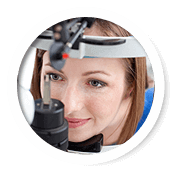What is Age-related Macular Degeneration?

Figure 1: Normal Macula
Age-related macular degeneration (AMD) is the leading cause of blindness in people over 65 years of age. There is deterioration of the central part of the retina, the macula (figure 1), which is the area that allows us to see color and detail. This is essential for activities such as driving, reading, and threading a needle. When the macula is not functioning properly, we experience blurriness and distortion in the center of our vision.
Both distance and near vision are affected. Total blindness does not occur. Therefore, people continue to have some useful vision and are generally able to take care of themselves.
The peripheral retina surrounds the macula. It is responsible for side and night vision, and it is not affected in AMD. For example, you might see the outline of a clock, but would not be able to tell what time it is.
Macular Degeneration Causes and Types
AMD is most commonly a result of the body’s natural aging process. There are two types of AMD. One is the dry or atrophic type (figures 2 and 3) and the other is the wet or exudative type (figures 4 and 5).
Dry AMD
Most people have the dry type of macular degeneration. In this type, the tissues break down and become thin with aging causing gradual loss of vision. Yellowish deposits called drusen accumulate under the retina (figure 2) and they usually do not affect vision significantly. In the more advanced stage, there can be a large atrophic area, referred to as geographic atrophy (figure 3), which is associated with loss of central vision.
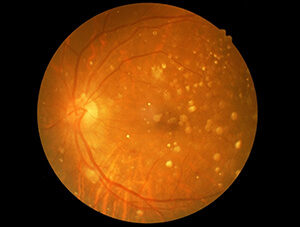
Figure 2: Dry Macular Degeneration with Drusen
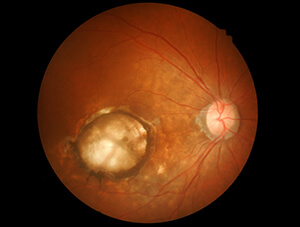
Figure 3: Dry Macular Degeneration with Geographic Atrophy
Wet AMD
Wet macular degeneration accounts for about 10% of all cases. It results when aging of the retina is compounded by growth of abnormal blood vessels, called choroidal neovascularization, underneath the macula. These vessels leak fluid and/or blood which distort the retinal tissue (figures 4 and 5) and blur central vision. Visual loss may be rapid and severe with significant distortion as a result of swelling of the retinal tissue and dense scar tissue formation (figure 5).
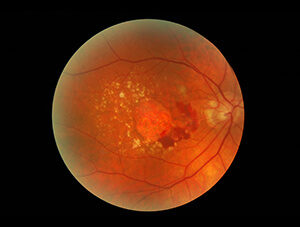
Figure 4: Wet Macular Degeneration with Blood Under the Macula.
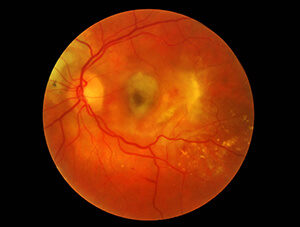
Figure 5: Wet Macular Degeneration with scar tissue formation.
Do I Have An Increased Risk For Macular Degeneration?
The most important risk is increasing age. Other risks include family history, European descent, smoking, obesity, excessive exposure to sunlight, high blood pressure and a diet deficient in fruits and vegetables.
Macular Degeneration Symptoms
Symptoms are variable. The condition may not be noticeable in its early stages. Sometimes there is loss of vision in only one eye while vision remains good in the other eye for many years.
When both eyes are affected, the loss of central vision is usually noticed earlier. Some common ways visual loss is detected include:
- Words in the center of a page appear blurred
- A dark or blind spot appears in the center of vision
- Straight lines appear wavy or distorted
- Colors decrease in intensity or brightness
How is Macular Degeneration Diagnosed?
Many people do not realize that they have a macular problem until blurred vision becomes obvious. Your ophthalmologist can detect early stages of the disease during an eye examination by:
- Examining the macula at the slit lamp microscope.
- Performing a simple test in which you look at a grid resembling graph paper called an Amsler grid to determine if you see the grid lines as wavy or distorted.
- Taking special photographs after a dye is injected in the arm to locate abnormal blood vessels and fluid under the macula. This procedure is called Fluorescein Angiography.
- Performing an Optical Coherence Tomography (OCT) scan. An OCT scan provides high resolution cross sectional images of the retina to determine if there is fluid under the macula by showing its thickness, to look at the size and location of the yellowish drusen deposits and to look for scar tissue formation under the macula.
How is Macular Degeneration Treated?
Dr George Khouri is fellowship trained in retinal diseases which makes him very well versed in the diagnosis and treatment of macular degeneration.
Dry AMD Management
There is no treatment for dry AMD at this time. The Age-Related Eye Disease Studies (AREDS) which were conducted by the National Eye Institute, showed that a certain combination of nutritional supplements may slow or prevent the degenerative process. These include vitamins C and E, lutein, zeaxanthin, zinc and copper. Regular use of the Amsler grid helps patients detect the development of wet macular degeneration so they can seek care with the ophthalmologist immediately.
Wet AMD Treatment
Wet macular degeneration is treated with Intravitreal Injections of different medications, such as Avastin, Lucentis and Eylea which stop the growth of leaking abnormal blood vessels, known as neovascularization, causing a delay in progression and sometimes visual improvement. These medications block vascular endothelial growth factors (VEGF) which have been found to be responsible for growth of the abnormal blood vessels. Intravitreal injections may have to be repeated to be effective. Serial OCT scans are usually repeated to follow treatment progress. However, this treatment is not curative.
Despite the treatment available, some people with AMD still experience significant visual loss. A wide range of low-vision devices, support services, and rehabilitation programs are available to help these patients maintain a satisfying lifestyle.
FAQs
What is macular degeneration?
Macular degeneration, also known as age-related macular degeneration (AMD), is a disease that affects the macula, the central portion of the retina responsible for sharp, detailed vision. Over time, it can cause blurry or lost central vision, making tasks like reading or recognizing faces more challenging.
What are the types of macular degeneration?
Dry Macular Degeneration: The most common form, where the macula thins over time, leading to gradual vision loss. While it progresses slowly, there is no cure.
Wet Macular Degeneration: This more severe type occurs when abnormal blood vessels form and leak under the retina, leading to rapid central vision loss. Immediate treatment is crucial to prevent significant damage.
What lifestyle changes can help manage macular degeneration?
Certain lifestyle changes can slow the progression of macular degeneration and protect eye health. These include:
Quit Smoking: Smoking is a major risk factor that can accelerate the disease.
Manage Blood Pressure: Controlling blood pressure can improve eye health by enhancing blood flow to the retina.
Maintain a Healthy Weight: Obesity and related conditions, such as heart disease, can worsen macular degeneration.
Wear Sunglasses: Protecting your eyes from UV light can reduce retinal damage.
Regular Exercise: Physical activity can support cardiovascular health, which positively impacts eye health.
What foods are good for supporting eye health in macular degeneration?
A balanced diet rich in certain nutrients can support eye health. Foods that are beneficial include:
Leafy Greens: Spinach, kale, and collard greens are packed with lutein and zeaxanthin, antioxidants that help protect the retina.
Fatty Fish: Salmon, tuna, and mackerel are rich in omega-3 fatty acids, which may reduce the risk of progression in dry AMD.
Nuts and Seeds: Almonds, walnuts, and flaxseeds provide vitamin E and healthy fats that support eye health.
Fruits and Vegetables: Foods high in vitamins C and E, like oranges, bell peppers, and strawberries, are essential for preventing cellular damage.
Eggs: A great source of lutein, zinc, and other eye-healthy nutrients.
How often should someone with macular degeneration see an eye doctor?
If you’ve been diagnosed with macular degeneration, it’s important to have regular follow-up appointments with your eye doctor to monitor the progression of the disease. Typically, patients with AMD should:
See their eye doctor at least once a year for a comprehensive eye exam.
If you have wet AMD or are undergoing treatment, you may need to see your eye doctor more frequently, typically every four to eight weeks for monitoring and treatment.
Follow any specific recommendations from your ophthalmologist based on the severity of your condition.
Can macular degeneration lead to complete blindness?
Macular degeneration typically does not cause complete blindness, as it primarily affects central vision. Peripheral vision is often preserved, meaning individuals with AMD can still see to the sides. However, the loss of central vision can severely impact daily activities such as reading, driving, or recognizing faces. In severe cases, especially with advanced wet AMD, the vision loss can be significant. Early diagnosis and management can help slow the progression of the disease and preserve as much vision as possible.
To find out if you can benefit from the treatments available for macular degeneration, contact us today to make an appointment to see Dr George Khouri.







